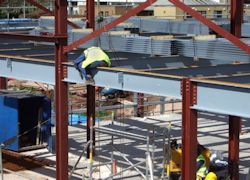Fall Hazards
A fall hazard is anything in the workplace that could cause an unintended loss of balance or bodily support and result in a fall.
- a worker walking near an unprotected leading edge trips over a protruding board;
- a worker slips while climbing an icy stairway;
- a makeshift scaffold collapses under the weight of four workers and their equipment; or
- a worker carries a sheet of plywood on a flat roof steps into a skylight opening.
Identify Hazardous Work Areas
Many work areas may not be considered hazardous, especially if employees work often in those areas.
- holes in walking/working surfaces that they could step into or fall through;
- elevated walking/working surfaces six feet or more above a lower level;
- skylights and smoke domes that workers could step into or fall through;
- wall openings such as those for windows or doors that workers could fall through;
- trenches and other excavations that workers could fall into;
- walking/working surfaces from which workers could fall onto dangerous equipment;
- hoist areas where guardrails have been removed to receive materials;
- sides and edges of walking/working surfaces such as established floors, mezzanines, balconies, and walkways that are 6 feet or more above a lower level and not protected by guardrails at least 39 inches high;
- ramps and runways that are not protected by guardrails at least 39 inches high;
- leading edges - edges of floors, roofs, and decks - that change location as additional sections are added; and
- wells, pits, or shafts not protected with guardrails, fences, barricades, or covers.
Consider Other Factors that Could Increase the Risk of Falls
When analyzing the workplace and activities for fall hazards, it's important to ask as many questions as you can to anticipate potential accidents.
- Will tasks expose workers to overhead power lines?
- Will they need to use scaffolds, ladders, or aerial lifts on unstable or uneven ground?
- Will they be working during hot, cold, or windy weather?
- Will workers need to frequently lift, bend, or move in ways that put them off balance?
- Will they be working extended shifts that could contribute to fatigue?
Knowledge Check Choose the best answer for the question.
3-6. A fall hazard is anything in the workplace that could _____ and result in a fall.
You forgot to answer the question!

